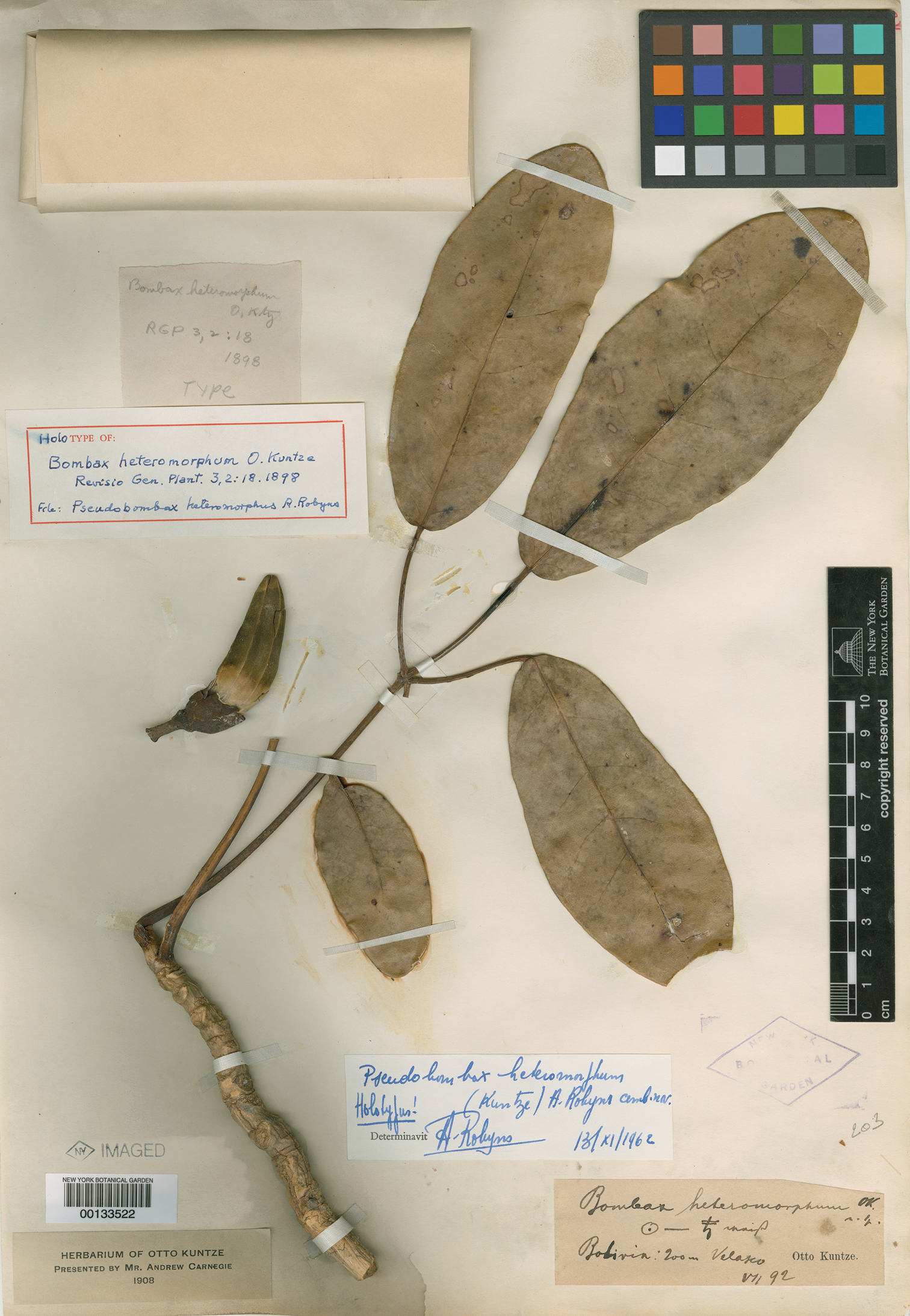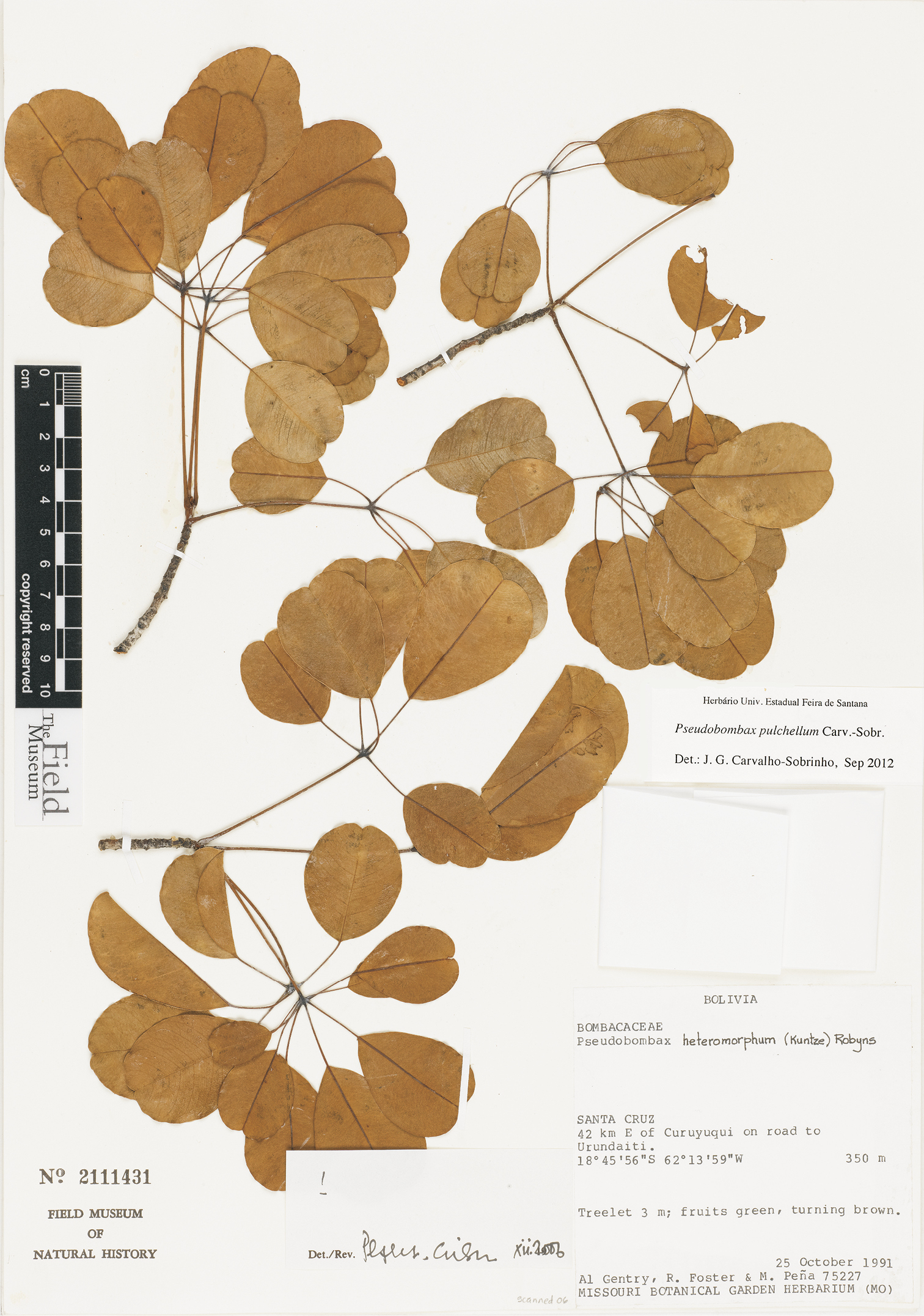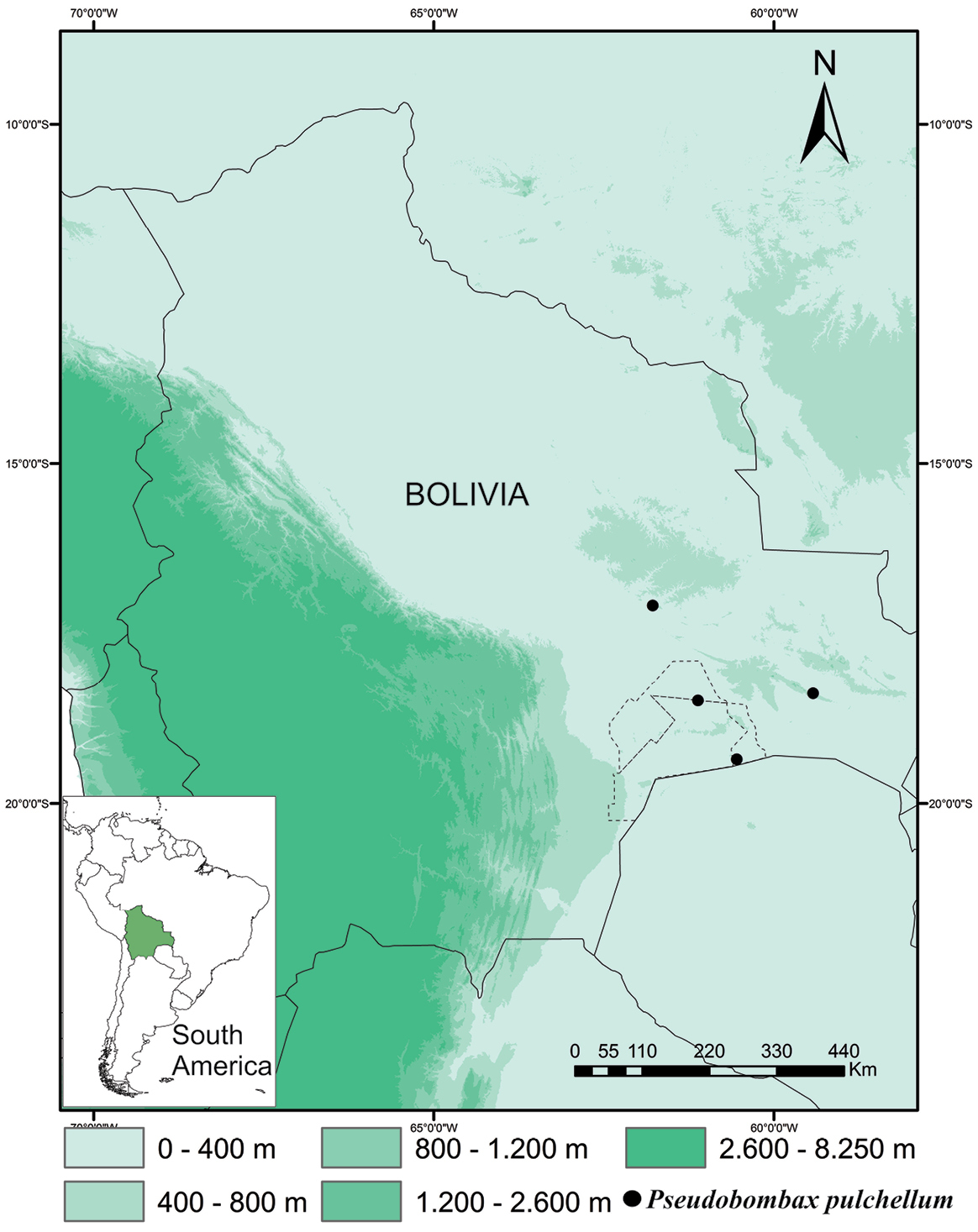






(C) 2013 Jefferson G. de Carvalho-Sobrinho. This is an open access article distributed under the terms of the Creative Commons Attribution License 3.0 (CC-BY), which permits unrestricted use, distribution, and reproduction in any medium, provided the original author and source are credited.
For reference, use of the paginated PDF or printed version of this article is recommended.
In the course of a taxonomic revision of Pseudobombax Dugand, one of us (JGCS) frequently has observed herbarium specimens of Bombacoideae that comprise a mixture of different Angiosperm families. In particular, Pseudobombax heteromorphum (Kuntze) A. Robyns, a frequent name in checklists of the Bolivian flora, is based on type material of Bombax heteromorphum Kuntze that is clearly a mixture of Pseudobombax flowers and Tabebuia Gomes ex DC. (Bignoniaceae) leaves. We herein designate as the lectotype of Bombax heteromorphum the flowers of an herbarium sheet deposited in NY and as epitype a complete specimen (leaves, flowers, and fruit) in HUEFS. We consider Bombax heteromorphum to be a synonym of Pseudobombax longiflorum (Mart.) A. Robyns, a species widespread in Neotropical seasonally dry forest of Bolivia, Brazil, Paraguay, and Peru. Furthermore, we describe a new species, Pseudobombax pulchellum Carv.-Sobr., apparently endemic to seasonally dry tropical forest (SDTF) in Bolivia (Chiquitano dry forest), based on specimens commonly but incorrectly identified as Pseudobombax heteromorphum.We also comment on the morphology, distribution, and conservation status of this new species.
Bombax, Chiquitano dry forest, new species, seasonally dry neotropical forest, Tabebuia, typification
In his revision of Bombax L. s.l.,
Photograph of the holotype of Bombax heteromorphum Kuntze (NY 133522).
In the course of a taxonomic revision of Pseudobombax (Carvalho-Sobrinho, in prep.), mixed collections of Bombacoideae, including type specimens based on mixtures, often have been observed. This is especially common for collections from seasonally dry Neotropical forest habitats where species often are leafless during the flowering period. In the present case, a careful examination of the morphology of the leaves and flowers of the holotype of Bombax heteromorphum revealed that the specimen is a mixture of reproductive and vegetative elements from two different Angiosperm families.
The holotype of Bombax heteromorphum (NY) and an image of an isotype (B as F negative 9535;
Having demonstrated above that the holotype of Bombax heteromorphum represents a mixture of leaves belonging to Tabebuia aurea and detached flowers belonging to a species of Pseudobombax it becomes necessary to select a lectotype from these two elements in order to fix the application of the name (
Pseudobombax longiflorum (Mart.) A. Robyns, Bull. Jard. Bot. État Bruxelles 33: 57. 1963.
= Bombax heteromorphum Kuntze, Revis. Gen. Pl. 3 (3): 18. 1898. Pseudobombax heteromorphum (Kuntze) A.Robyns, Bull. Jard. Bot. État Bruxelles 33: 80. 1963. Lectotype (designated here): BOLIVIA. Velasco, O.Kuntze s.n. (NY flowers only!). Epitype (designated here): BRAZIL. Bahia, Inhaúmas, ca. 10 km de Inhaúmas na estrada para Santa Maria da Vitória, Cerrado, 13°13'47"S, 44°33'09"W, 600 m alt., 15 Aug 2005, Carvalho-Sobrinho & Queiroz 577 (HUEFS 100549!, lf, fl, fr, in two sheets).
urn:lsid:ipni.org:names:77128380-1
http://species-id.net/wiki/Pseudobombax_pulchellum
Figs 2, 3Similar to Pseudobombax longiflorum (Mart.) A.Robyns by its long petiolules, obovate to suborbicular leaflets, and maculate seeds, but differing by the smaller leaves, flowers and fruits, slender branches, petioles 4 times the length of the petiolules (vs. a petiole/petiolule ratio of 6–12 in Pseudobombax longiflorum), and fruits acuminate for the distal 20% of their length (vs. 3%–5% in Pseudobombax longiflorum).
BOLIVIA. Santa Cruz: 42 km E of Curuyuqui, 18°45'56"S, 62°13'59"W, 350 m, 25 October 1991 (lf, fr), A. Gentry, R. Foster & M. Peña 75227 (holotype: MO!; isotypes: F!, LPB!, USZ!, WIS!).
Treelets3–8 m, deciduous; branches glabrous, relatively slender, often covered with pale wax; brachyblasts absent. Stipules not seen. Leaves palmately compound, clustered at apex of the branches; petioles (17–) 34–87 mm long, flattened, slender, glabrous, usually glaucous with pale wax at the ends, bases slightly thickened, apices slightly thickened to 3–4 mm diam.; petiolules 14–22 mm long; leaflets (4) 5 (7), chartaceous, proximal leaflets 17–38 × 9–30 mm, distal leaflets 45–57 (–75) × 29–51 mm, obovate, broadly elliptic to suborbicular, apices retuse, rarely acuminate, bases obtuse, rounded, truncate to slightly cordate, margins entire, glabrous on both surfaces, except for sparse, peltate microtrichomes, abaxial surface dull-brown in dried state, midrib prominent abaxially, 8–12 secondary veins inconspicuous, intersecondary veins present, tertiary veins reticulate. Complete inflorescences not seen; pedicels 19 mm long (–26 mm when in fruit). Flowers c. 65 mm long; receptacle with single whorl of c. 5 glands; calyces 8–9 × 11–15 mm, cupular to campanulate, truncate, outwardly glabrous except for peltate microtrichomes, internally sericeous; petals (50–) 61–70 × 6–8 mm, linear to lanceolate, apex acute, dark-brown externally, covered with tufted, rigid hairs, inwardly pilose to glabrescent towards the base, covered mainly by verrucose microtrichomes; stamens c. 150–200, staminal tube 9–10 × 4 mm, pubescent, phalanges absent, filaments free for 40–58 mm, anthers hippocrepiform c. 2 mm long; ovary 5 × 2 mm, oblong-obovoid, glabrous except for peltate microtrichomes, style c. 70 mm long, glabrous, stigma inconspicuously 5-lobed. Capsules c. 90 mm long, woody, oblong-obovoid, conspicuously acuminate for distal 15 mm or so, valves coriaceous, glabrous, kapok abundant, golden brown. Seeds c. 5 mm diam., subglobose to pyriform, maculate, glabrous.
Photograph of an isotype of Pseudobombax pulchellum Carv.-Sobr. (Gentry et al.75227, F 2111431).
Distribution of Pseudobombax pulchellum Carv.-Sobr. in Santa Cruz, Bolivia. Dashed lines indicate the boundaries of the Kaa-Iya del Gran Chaco National Park.
Pseudobombax pulchellum is known from only four sites in the Department of Santa Cruz, Bolivia, and appears to be endemic to Chiquitano dry forest at elevations of 230 to 520 m.
Flowers of this new species are known from a single collection made in June; fruiting material was collected in October.
The specific epithet refers to the small, delicate leaflets and long, slender petiolules of this species, diagnostic even in sterile specimens. The epithet also honors the Brazilian botanist Aline Costa da Mota for her important insights and collaboration on the systematics of Bombacoideae.
Although Pseudobombax pulchellum occurs in the Kaa-Iya del Gran Chaco National Park, itmust be considered Near Threatened because it is known from only four sites and “there are plausible events that may cause the species to decline, but these are unlikely to make the species Extinct or Critically Endangered in a short time” (
BOLIVIA. Santa Cruz: Chiquitos, 19–23 Dec 1993 (fr), G. Navarro Sanchez 2192 (LPB!); Cordillera, 09 January 1993 (lf), G. Navarro Sanchez 1713 (MO!, USZ!); ibidem, 18°29'20"S, 61°07'06"W, 230 m, 17 June 1998 (fl), Alfredo F. Fuentes & G. Navarro Sanchez 2436 (MO!); Ñuflo de Chavez, 17°05'00"S, 61°47'00"W, 400 m, 24 October 1995 (lf), Alfredo F. Fuentes 1132 (LPB!, USZ, WIS!).
Pseudobombax pulchellum is a remarkable species by its diminutive aspect, especially the relatively small, retuse, obovate to suborbicular leaflets, and the flowers; the petiolules are markedly long in relation to the petiole, and fruits are conspicuously acuminate. It seems to be closely related to Pseudobombax longiflorum (Mart.) A. Robyns, a sympatric congener in Bolivian Chiquitano dry forest. The two are similar because of their glabrous aspect, long petiolules, leaflets with retuse apices, truncate to cordate bases, and maculate seeds.
The new species is also similar to Pseudobombax croizatii A.Robyns and Pseudobombax minimum Carv.-Sobr. & L.P. Queiroz; both of these species share small flowers (60–65 mm long), glabrous staminal tubes, androecia with relatively few stamens (c. 150–200), and glabrous fruits. The following key can be used to separate these four species of Pseudobombax.
| 1 | Petiolules 14–75 mm long. Petals externally blackish, staminal tube lacking phalanges (filaments freely originating from the apex of the tube). Seeds bicolored, maculate | 2 |
| – | Petiolules to 5 mm long. Petals externally cream-colored, staminal tube originating phalanges 3–5 mm long. Seeds uniformly colored | 3 |
| 2 | Petioles 4 times the length of the petiolules. Flowers c. 65 mm long, calyx 8–9 mm long, staminal tube c. 10 mm long. Capsules c. 90 mm long, acuminate for the distal 20% of their length | Pseudobombax pulchellum (Bolivia) |
| – | Petioles 6–12 times the length of the petiolules. Flowers 15–22 mm long, calyx 15–25 mm long, staminal tube 35–60 mm long. Capsules 14–24 mm long, acuminate for the distal 3%–5% of their length | Pseudobombax longiflorum (Bolivia, Brazil, Paraguay, Peru) |
| 3 | Leaflets 7–9, obovate, cuneate, margins revolute. Flowers to 60 mm long, staminal tube glabrous. Capsules 55 mm long, not acuminate | Pseudobombax minimum (Central Brazil) |
| – | Leaflets 5, elliptic to broad-elliptic, acute, margins plane. Flowers 85–100 mm long, staminal tube with bands of simple trichomes. Capsules c. 70 mm long, acuminate | Pseudobombax croizatii (Colombia, Venezuela) |
Thanks are due Hibert Huaylla for photographs of Bombacoideae specimens from Bolivia; the staff and curators of F (especially Nancy Hensold and Robin Foster), LPB, MO, NY, and WIS for scanned images; the reviewers and the subject editor for their suggestions to the manuscript; the Fundação de Amparo à Pesquisa do Estado da Bahia (process APP0006/2011) and the Conselho Nacional de Desenvolvimento Científico e Tecnológico–CNPq (processes 300811/2010-1 and 563546/2010-7-REFLORA) for financial support. This paper is part of the PhD thesis of JGCS prepared in the Programa de Pós-Graduação em Botânica (PPGBot-UEFS) and supported by a grant from the Coordenação de Aperfeiçoamento de Pessoal de Nível Superior–CAPES.


